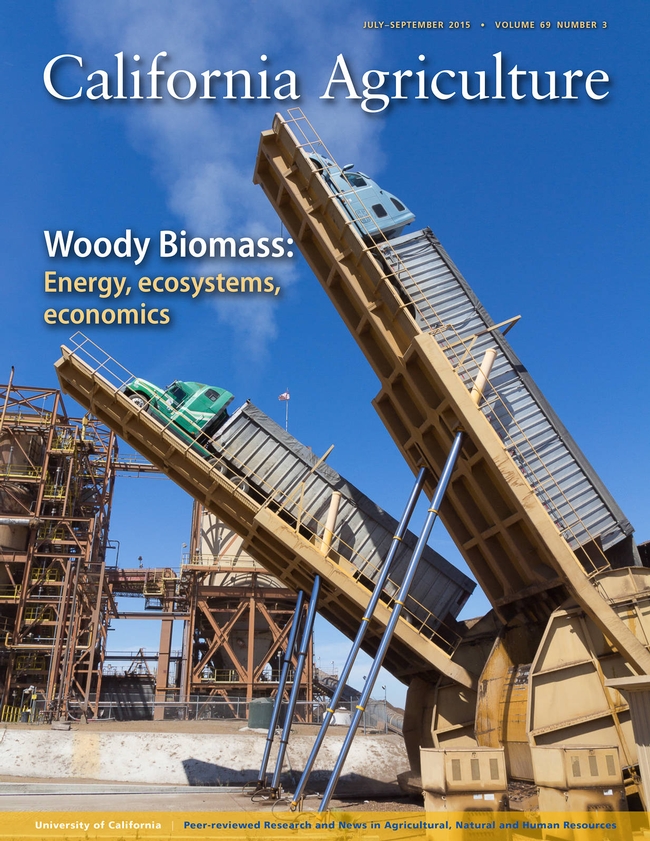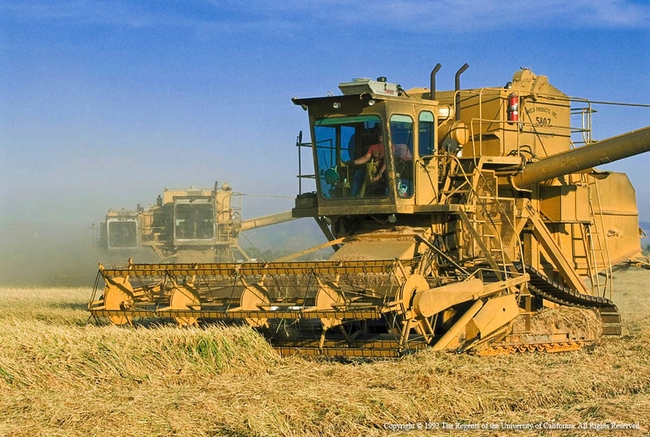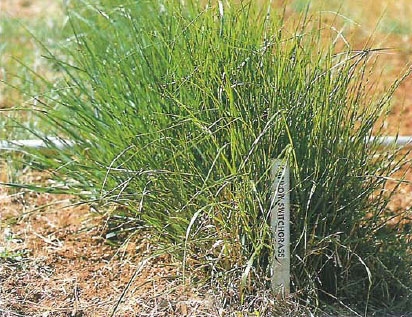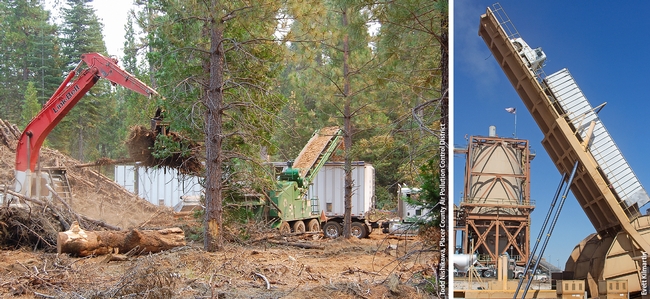Posts Tagged: biomass
What to do with woody waste in forests?

One way of disposing of the woody material is to burn it in biomass power plants to generate energy. However, nearly half of the power plants in California that run on woody biomass are operating on contracts that are set to expire in 2016, and low-cost solar power may deter utilities from renewing those contracts.
In his Outlook article, “The wood in the forest: Why California needs to reexamine the role of biomass in climate policy,” Peter Tittmann, academic coordinator for the Woody Biomass Utilization Group at UC Berkeley, writes, “By incentivizing better forest management and improved forest health, biomass energy leverages considerable climate and other environmental benefits beyond the direct reductions in carbon emissions from generating electricity from a renewable resource.”
UC scientists are evaluating the feasibility of using small, portable biomass power generators that could be moved to a forest thinning site, reducing the cost of transporting the biomass to a plant. Electricity generated in remote locations could be sold for a premium. Read more in “Following the fuel: How portable biomass energy generation may help rural communities.”
Peer-reviewed articles:
Forest biomass diversion in the Sierra Nevada: Energy, economics and emissions
In a Sierra Nevada case study, converting forest waste to electricity yielded energy and emission benefits, but was not economically viable. The authors suggest financial incentives for reduced air pollution could compensate.
Effects of fuel treatments on California mixed-conifer forests
Contrary to what some environmentalist advocates have argued, prescribed fire, mastication and thinning to modify wildfire behavior may have positive effects on the ecology of yellow pine and mixed-conifer forests.
Thinning treatments had minimal effect on soil compaction in mixed-conifer plantations
In mixed-conifer plantations in the Sierra Nevada, no large impacts were seen from commercial thinning or chipping treatments.
Modeling fuel treatment impacts on fire suppression cost savings: A review
Fuel treatments appear to reduce future fire suppression costs, but the savings are unlikely to fully offset the cost of the treatments.
To read all of the articles in the current California Agriculture, visit http://californiaagriculture.ucanr.edu.
California Agriculture is a peer-reviewed journal of research in agricultural, human and natural resources published by UC ANR. For a free subscription, visit californiaagriculture.ucanr.edu, or write to calag@ucanr.edu.
Generating energy from forest products
Thinning a forest of woody materials has multiple objectives. It can increase the resiliency of the remaining trees from the effects of fire, drought, pest and disease; it can improve habitat quality for wildlife including watersheds; and it can make it easier for firefighters to protect human lives and livelihoods when a fire is burning. There are several ways thinning is carried out: cable logging, feller bunching, conventional tractor skidding, hand-thinning and piling, and mastication. One of the issues with thinning is the disposal of biomass that is non-merchantable (e.g., branches, tree tops, small diameter trees). Typically this material goes into large slash piles. For the most part, these piles are left in the forest to break down naturally under winter rain and snows, and are later burned. Because of strict air quality rules, forest managers have very small windows of opportunity to burn these piles, so they are often left on the landscape for many years, sometimes becoming a fire hazard themselves.
Forested communities are searching for ways to deal with this residual biomass that will improve the health of the forest ecosystem; improve and protect critical watersheds and wildlife habitat; reduce the amount of air pollution by removing the piles instead of burning them; and reduce the critical fire danger to their communities. The Placer County Biomass Program is taking up this challenge by chipping the slash piles and trucking the chips to a biomass facility to be converted into electricity.
Outside of Foresthill, Calif., the Tahoe National Forest American River Ranger District and the Sierra Nevada Adaptive Management Project (SNAMP) have been collaborating on a study of forest fuels reduction treatments carried out on national forests. The eight-year ‘Last Chance’ study involves independent third party research by University of California scientists of the integrated effects of forest thinning on fire hazard, forest health, wildlife, water quality and quantity, and public participation. The Placer County Biomass Program, in conjunction with the Tahoe National Forest, the Sierra Nevada Conservancy (SNC) and the Placer County Air Pollution Control District, proposes to remove some of the biomass waste from the Last Chance project to provide an alternative to open burning of the piles. Local contractors are hired to grind the material on-site, load the material into chip vans, and bring the material to market within 60 miles of the Last Chance site to create green, renewable electricity. Placer County estimates that roughly 3,000 Bone Dry Tons (BDTs) of biomass can be removed. According to UC researchers, one BDT burned in a typical commercial boiler fuel will produce 10,000 pounds of steam and 10,000 pounds of steam will produce about 1,000 horsepower or generate 1 megawatt hour (MWH) of electricity.
The economics of this project will be used as part of the assessment of locating a biomass energy facility in the Foresthill area. The removal of these biomass piles will greatly reduce the possibility of catastrophic fire to the local communities on the Foresthill Divide. The improved forest and watershed health will be noticed by the local community and the surrounding county which derives recreation and watershed benefits from the American River area. In addition, several tons of air pollutants will be avoided by removing the pile burns from this area which is currently a federal non-attainment basin that carries both business and health risks to the local population.
Though this project is of benefit to the Foresthill community, other communities in the wild-land urban interface aren’t as lucky. According to Brandon Collins, research scientist at the Pacific Southwest Research Station and UC Berkeley, the lack of funding to chip and remove slash piles and the lack of infrastructure or facilities to take the chips to, makes it impossible at this time to remove that biomass at a larger scale.
“There is so much woody material on the landscape as a result of fire exclusion, it could take decades to really get a handle on it," Collins said. "However, any effort to remove thinning residues from the forest and to also get a benefit from it, such as energy, is great and should be supported.”

Slash pile in Tahoe National Forest, Last Chance project.

Slash pile under a controlled burn.

Workers bunch slash.

Slash piles are chipped and trucked to biomass facility.
Rice growers optimistic; seeking biomass growers

Harvesting jet fuel
Kathy Johnston, (San Luis Obispo) New Times
Reporter Kathy Johnston examined both government and grower interest in camelina sativa, an oilseed crop that can be used in jet fuel. Growers interested in camelina can sign up for USDA's Biomass Crop Assistance Program, the deadline for which has been extended. The reporter talked with Steve Kaffka, UC Cooperative Extension agronimist in Davis and director of the California Biomass Collaborative, who is seeking cooperating growers for trial plantings of camelina under local conditions this winter. “It hasn’t been adapted specifically for California. We’re trying to figure out what conditions it likes, the range of rainfall and soil types where it might be suitable in San Luis Obispo County,” Kaffka told the reporter.
She also talked to Royce Larsen, UC Cooperative Extension natural resources advisor in San Luis Obispo county, who explained that though meetings about the crop have been well attended, no San Luis Obispo growers have signed up for the program yet. “A lot of people showed up [at a meeting about camelina in Templeton] with great interest, but they left, I think, a little downhearted,” Larsen told the reporter. “The bottom line is it’s too new, with too many unknowns for people to want to jump on board and give this a try."
(Though this article is about San Luis Obispo county, other California counties included in this project area are Butte, Colusa, Fresno, Glenn, Kern, Kings, Madera, Merced, Riverside, Sacramento, San Joaquin, Solano, Stanislaus, Riverside, Tehama, Tulare and Yolo, according to an article on the California Ag Network website.)
Biomass may help solve world energy problems
UC Cooperative Extension forage specialist Dan Putnam believes California farmers need to envision and implement biomass-based, highly productive food, fuel and energy production systems to meet the increasing demands of the growing world population.
Putnam's thoughts were written up by reporter Cary Blake and posted yesterday on the Western Farm Press website.
The article noted that one biomass crop showing potential in California is switchgrass, which is grown in other parts of the country for forage. Putnam has four switchgrass trials underway.
"The switchgrass yields, especially in the Central Valley, California trials, are quite impressive on good soils with irrigation," Putnam was quoted in the story. "Yields have reached 18 tons per acre — some of the highest switchgrass yields recorded in the nation."
The fact that switchgrass may not need water year round is another favorable attribute. The plant's deep root system enables it to survive in low water conditions.
"This is very encouraging, especially in California where water supplies are an ongoing concern," Putnam said.
Putnam urged farmers to cautiously investigate biomass to determine how it may fit into their diversification portfolio.
"The next few years should be an exciting ride for U.S. agriculture in terms of new opportunities in the energy sector," Blake wrote in closing.

Switchgrass is a possible biofuel crop.
